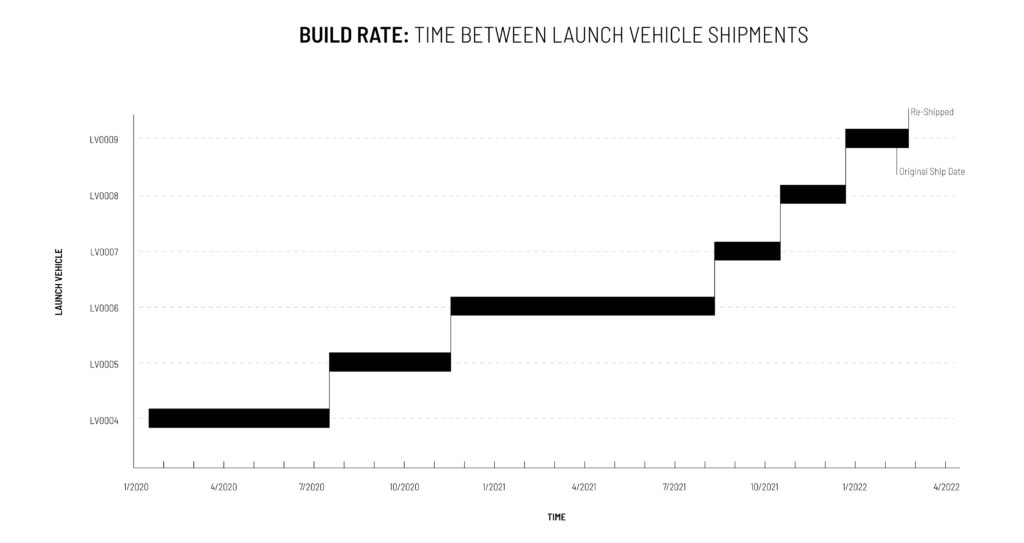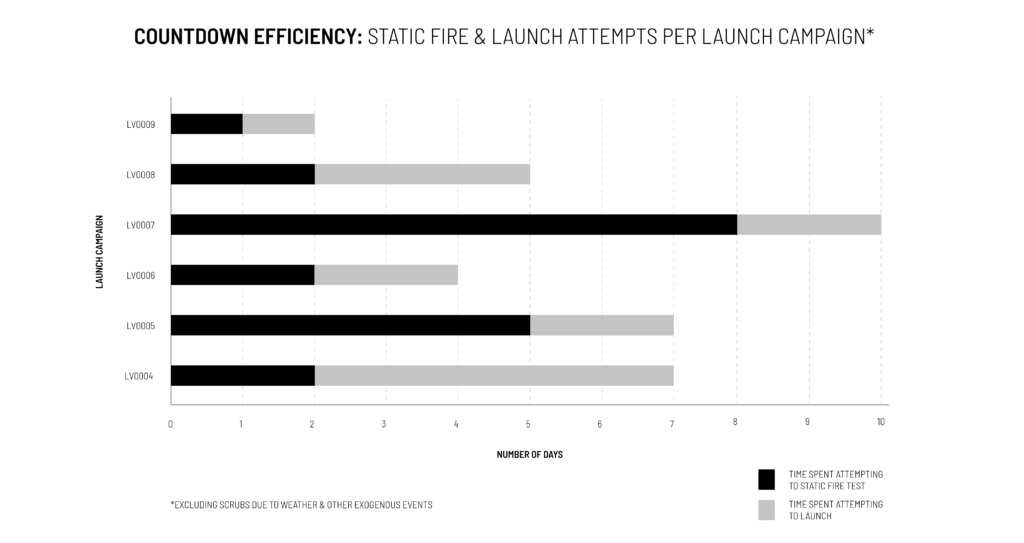By Bryson Gentile, Vice President of Operations
On March 15, 2022, Astra successfully delivered 22 satellites to a circular sun-synchronous orbit (SSO) out of the Astra Spaceport in Kodiak, Alaska. In addition to delivering our first customer satellites to orbit, this mission demonstrated operational progress toward our goal of a daily launch capability that we believe will dramatically improve access to space.
Though rocket science comes with many unknowns and risks (see our disclosures on file with the SEC) the operational measures we track as we make progress toward that goal include:
-
- Launch Cadence: This is our ultimate measurement that enables us to deliver for our customers. We’ve been working toward decreasing the number of days between launches and we hope that this trend will continue. Notably, between LV0008 and LV0009, the team completed our LV0008 investigation incorporated corrective actions into LV0009, tested the updates, and returned to the launch pad to commence operations for this mission. You’ll notice that the turnaround time for LV0006 is longer than the others due to updates we made to the vehicle.

- Build Rate: This is the cadence, or takt, at which we deliver new rockets out of the factory. We are currently producing a rocket a month, and aim to increase this cadence this calendar year. Operating in continuous production means that we usually have an upcoming vehicle in stock or in transit while we’re launching one on the pad. By the time we launched LV0008, LV0009 had already shipped to Kodiak. After the launch of LV0008, Astra was able to return LV0009 to the factory to make repairs identified from the LV0008 anomaly. Having a complete rocket on hand was a tremendous asset towards finding the root cause of LV0008’s anomaly. Our team was able to quickly validate our corrective actions against real flight hardware before shipping LV0009 again a few weeks later, demonstrating our ability to rapidly iterate and improve with every launch vehicle iteration.

- Campaign Length — Total Time from First Site Set Up to Final Teardown: After arriving in Kodiak with LV0009, we set up our launch system and completed tests and checkouts on site. We aim to static fire test, launch, and then safe the site and pack the site back into shipping containers within three weeks. A campaign without site setup and teardown in between has the potential to be even faster.

- Countdowns Per Launch: We have now had two vehicles in a row (LV0008 and LV0009) that lifted off in the first minute of the launch window, demonstrating a well-timed, repeatable operation that we hope continues. The duration of the campaign for LV0007 taught us a lot of great lessons about how to design for operating in strenuous weather environments. This sort of testing is common in the automotive world, where early cars are sent to extreme environments to ensure they can operate in the worst conditions. We incorporated those lessons and got back to a cold weather site with LV0009 and while lightning concerns prevented us from launching on the first day of our window for LV0009, we returned to the pad the next day, had a clean launch count, and launched right on time in the first minute of the window. As we scale our operations, we’ll continue to test in extreme conditions.

We are proud of our team for the progress that has been made and we continue to focus on delivering access to space at scale. While we have demonstrated a shorter return to the pad with LV0009, we may increase time between launches to prepare for our new launch system or due to other conditions outside our control, including availability of launch dates at our spaceports.
Be sure to check out our gallery from Spaceflight’s Astra-1 mission here.
—
Safe Harbor Statement
Certain statements made in this press release are “forward-looking statements”. Forward-looking statements may be identified by the use of words such as “anticipate”, “believe”, “expect”, “estimate”, “plan”, “outlook”, and “project” and other similar expressions that predict or indicate future events or trends or that are not statements of historical matters. These forward-looking statements reflect the current analysis of existing information and are subject to various risks and uncertainties, including Astra’s failure to meet the projected launch targets. As a result, caution must be exercised in relying on forward-looking statements. Due to known and unknown risks, actual results may differ materially from Astra’s expectations or projections including the following factors, among others: projected development and launch targets, including as a result of the decisions of governmental authorities or other third parties not within our control, weather and other suboptimal conditions that may make it difficult to perform a launch attempt; (ii) changes in applicable laws or regulations; (iii) the ability of Astra to meet its financial and strategic goals, due to, among other things, competition; (iv) the ability of Astra to pursue a growth strategy and manage growth profitability; (v) the possibility that Astra may be adversely affected by other economic, business, and/or competitive factors; (vi) the effect of the COVID-19 pandemic on Astra, (vii) the ability to manage its cash outflows during its pre-revenue business operations and (vii) other risks and uncertainties discussed from time to time in other reports and other public filings with the Securities and Exchange Commission by Astra.